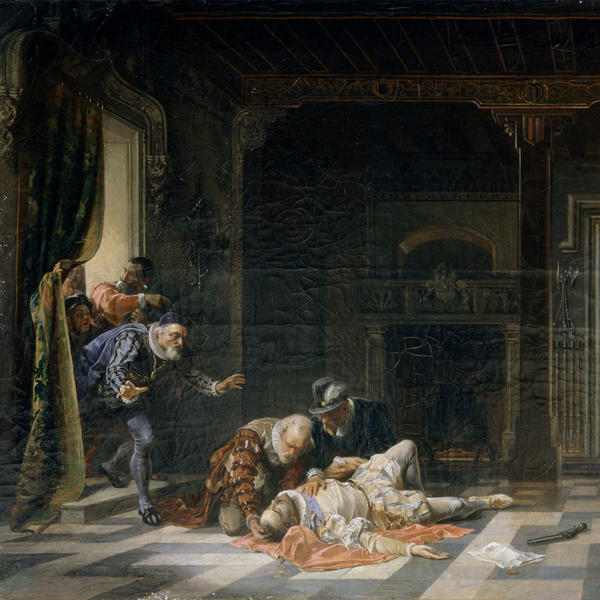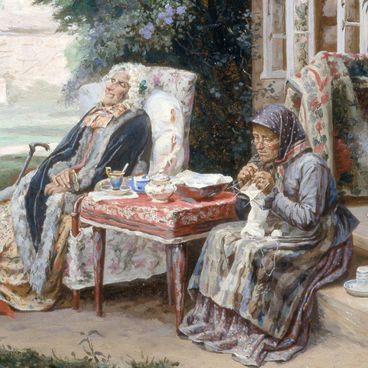Historical painting was considered the most important of all academic genres for many years. Academic artists painted real significant historical events and created canvases on mythological and religious topics. The painting Death of Prince of Orange by Stanislaw Chlebowsky presented at the exhibition also refers to historical painting.
The event shown in the painting dates back to the epoch of the Dutch Revolt when Northern provinces of the country struggled for their independence from Spain. Prince William of Orange was the leader of the revolt leading the Northern provinces together with Count of Egmont in the struggle against the Spanish domination. In 1584, the Prince of Orange was assassinated in Delft by Balthazar Gerard directed by Catherine de Medici. While the Prince of Orange was reading Catherine’s letter, a pistol went off crack leaving dead the hero of the revolt.
The painting composition vividly shows the artist’ narrative mastery. The figure of the main character is in the center at the forefront and, in addition, the artist emphasizes it with light. The painting action unfolds like on the stage, the characters’ gestures and poses being full of expression. The master uses details pushing forward the narration –a letter and a pistol on the floor. The mayor, with a key hanging on his chest, is rushing to the murdered man. Chlebowsky, as a true academic painter, shows the scene of the assassination with utmost tact: he does not paint blood, it is symbolized by the Prince’s cape.
The canvas Death of Prince of Orange is connected with the history of the museum collection. It was part of 19 paintings, drawings and sculptures sent to Arkhangelsk from the Imperial Academy of Arts in 1916 in response to the request of the members of a fine arts circle dreaming of setting up the Arkhangelsk Fine Arts Museum. The painting arrived at the museum under the name of Assassination of Prince Condé, and only thanks to some painting details it became possible to establish the real title of the canvas.
Polish by origin, artist Stanislaw Chlebowsky graduated from the Saint Petersburg Academy of Arts. During his studies, he was many times awarded with gold and silver medals for his historical canvases. On his pension trip organized by the Academy, he travelled in Europe – visited France, Belgium, Spain where he improved his mastery and trained in Munich and Paris.
After his trip around Europe, Chlebowsky did not come back to Russia. For many years, he worked as the Turkish Sultan court painter and lived in Constantinople where he painted battle-pieces and the Sultan’s portraits. After that he travelled in Egypt, visited Vienna, Dresden, Paris, Krakow. Then he went back to France where he organized a studio holding a big collection of Oriental handicrafts, weapons, textiles. Chlebowsky’s paintings are kept in many museums of the world, including the Tretiakov Gallery.
The event shown in the painting dates back to the epoch of the Dutch Revolt when Northern provinces of the country struggled for their independence from Spain. Prince William of Orange was the leader of the revolt leading the Northern provinces together with Count of Egmont in the struggle against the Spanish domination. In 1584, the Prince of Orange was assassinated in Delft by Balthazar Gerard directed by Catherine de Medici. While the Prince of Orange was reading Catherine’s letter, a pistol went off crack leaving dead the hero of the revolt.
The painting composition vividly shows the artist’ narrative mastery. The figure of the main character is in the center at the forefront and, in addition, the artist emphasizes it with light. The painting action unfolds like on the stage, the characters’ gestures and poses being full of expression. The master uses details pushing forward the narration –a letter and a pistol on the floor. The mayor, with a key hanging on his chest, is rushing to the murdered man. Chlebowsky, as a true academic painter, shows the scene of the assassination with utmost tact: he does not paint blood, it is symbolized by the Prince’s cape.
The canvas Death of Prince of Orange is connected with the history of the museum collection. It was part of 19 paintings, drawings and sculptures sent to Arkhangelsk from the Imperial Academy of Arts in 1916 in response to the request of the members of a fine arts circle dreaming of setting up the Arkhangelsk Fine Arts Museum. The painting arrived at the museum under the name of Assassination of Prince Condé, and only thanks to some painting details it became possible to establish the real title of the canvas.
Polish by origin, artist Stanislaw Chlebowsky graduated from the Saint Petersburg Academy of Arts. During his studies, he was many times awarded with gold and silver medals for his historical canvases. On his pension trip organized by the Academy, he travelled in Europe – visited France, Belgium, Spain where he improved his mastery and trained in Munich and Paris.
After his trip around Europe, Chlebowsky did not come back to Russia. For many years, he worked as the Turkish Sultan court painter and lived in Constantinople where he painted battle-pieces and the Sultan’s portraits. After that he travelled in Egypt, visited Vienna, Dresden, Paris, Krakow. Then he went back to France where he organized a studio holding a big collection of Oriental handicrafts, weapons, textiles. Chlebowsky’s paintings are kept in many museums of the world, including the Tretiakov Gallery.



